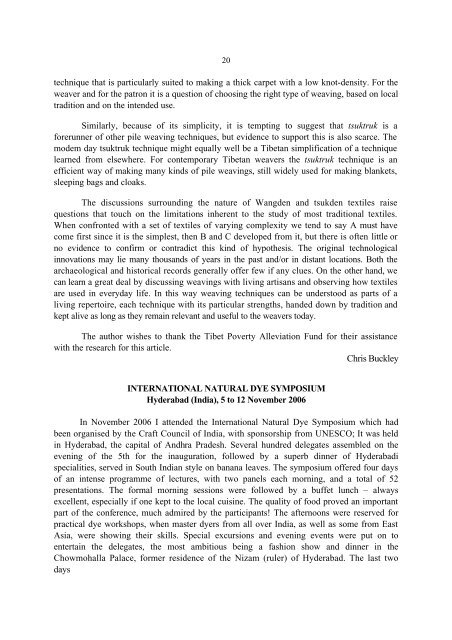download - OATG. Oxford Asian Textile Group
download - OATG. Oxford Asian Textile Group
download - OATG. Oxford Asian Textile Group
- No tags were found...
Create successful ePaper yourself
Turn your PDF publications into a flip-book with our unique Google optimized e-Paper software.
20technique that is particularly suited to making a thick carpet with a low knot-density. For theweaver and for the patron it is a question of choosing the right type of weaving, based on localtradition and on the intended use.Similarly, because of its simplicity, it is tempting to suggest that tsuktruk is aforerunner of other pile weaving techniques, but evidence to support this is also scarce. Themodem day tsuktruk technique might equally well be a Tibetan simplification of a techniquelearned from elsewhere. For contemporary Tibetan weavers the tsuktruk technique is anefficient way of making many kinds of pile weavings, still widely used for making blankets,sleeping bags and cloaks.The discussions surrounding the nature of Wangden and tsukden textiles raisequestions that touch on the limitations inherent to the study of most traditional textiles.When confronted with a set of textiles of varying complexity we tend to say A must havecome first since it is the simplest, then B and C developed from it, but there is often little orno evidence to confirm or contradict this kind of hypothesis. The original technologicalinnovations may lie many thousands of years in the past and/or in distant locations. Both thearchaeological and historical records generally offer few if any clues. On the other hand, wecan learn a great deal by discussing weavings with living artisans and observing how textilesare used in everyday life. In this way weaving techniques can be understood as parts of aliving repertoire, each technique with its particular strengths, handed down by tradition andkept alive as long as they remain relevant and useful to the weavers today.The author wishes to thank the Tibet Poverty Alleviation Fund for their assistancewith the research for this article.Chris BuckleyINTERNATIONAL NATURAL DYE SYMPOSIUMHyderabad (India), 5 to 12 November 2006In November 2006 I attended the International Natural Dye Symposium which hadbeen organised by the Craft Council of India, with sponsorship from UNESCO; It was heldin Hyderabad, the capital of Andhra Pradesh. Several hundred delegates assembled on theevening of the 5th for the inauguration, followed by a superb dinner of Hyderabadispecialities, served in South Indian style on banana leaves. The symposium offered four daysof an intense programme of lectures, with two panels each morning, and a total of 52presentations. The formal morning sessions were followed by a buffet lunch – alwaysexcellent, especially if one kept to the local cuisine. The quality of food proved an importantpart of the conference, much admired by the participants! The afternoons were reserved forpractical dye workshops, when master dyers from all over India, as well as some from EastAsia, were showing their skills. Special excursions and evening events were put on toentertain the delegates, the most ambitious being a fashion show and dinner in theChowmohalla Palace, former residence of the Nizam (ruler) of Hyderabad. The last twodays
















